100+ Short Answer Questions Across Bloom’s Taxonomy Levels
Short answer questions are a powerful tool for educators, yet many teachers find themselves struggling to craft questions that are both effective and engaging. Often, the challenge lies in creating prompts that accurately assess student understanding without being too vague or overly complex. This struggle can lead to frustration for both teachers and students, as poorly designed questions fail to achieve their educational goals.
By exploring targeted examples of short answer questions, educators can overcome these pain points and enhance their assessments. In this blog, we delve into a variety of short answer questions tailored to different levels of Bloom’s Taxonomy. These examples are designed to inspire and guide teachers in creating questions that not only test factual knowledge but also promote critical thinking and deeper understanding.
From basic recall to advanced analysis and creation, these short answer questions will help you engage your students and improve learning outcomes across the board.
What is a Short Answer and Why Is It Important?
Short answer questions are concise prompts that require students to respond with brief, yet thoughtful, answers. Unlike essay questions that demand lengthy, structured responses, short answer questions call for clear and direct answers that can range from a single sentence to a short paragraph. The key distinction lies in the depth and breadth of the response; essays allow for more extensive exploration and elaboration of ideas, while short answer questions focus on pinpointing specific knowledge or insights.
Differences Between an Essay and a Short Answer
| Aspect | Essay | Short Answer |
|---|---|---|
| Length | Extended response, typically multiple paragraphs | Brief response, usually a sentence to a short paragraph |
| Structure | Requires a structured format (introduction, body, conclusion) | Generally lacks formal structure, focused on the key points |
| Depth of Response | Allows for in-depth analysis and detailed arguments | Aims for brevity and precision, highlighting key points |
| Purpose | Assesses comprehensive understanding and articulation of complex thoughts | Gauges specific knowledge and understanding of particular concepts |
| Usage | Often used in exams, major assignments, and research papers | Ideal for quizzes, classwork, and quick assessments |
| Time to Complete | Requires significant time for both writing and grading | Quick to complete and grade |
| Skill Development | Enhances research, organization, and extended writing skills | Improves clarity, precision, and concise communication skills |
Why Short Answer Questions Are Important
Short answer questions hold a critical place in the educational landscape for several reasons:
- Focused Formative Assessment: They help teachers quickly assess specific knowledge and understanding of key concepts.
- Encourages Clarity: Students must be clear and precise in their responses, which improves their ability to communicate effectively.
- Time-Efficient: Both creating and grading short answer questions is generally quicker than essays, making them ideal for frequent assessments.
- Versatile Usage: They can be used across various subjects and grade levels to test factual knowledge, comprehension, and critical thinking skills.
- Promotes Active Learning: Short answer questions encourage students to actively engage with the material and think critically about their responses.
Check out these Bloom's Taxonomy inspired formative assessment questions.
Short Answer Questions for Bloom’s Taxonomy Level, Remembering
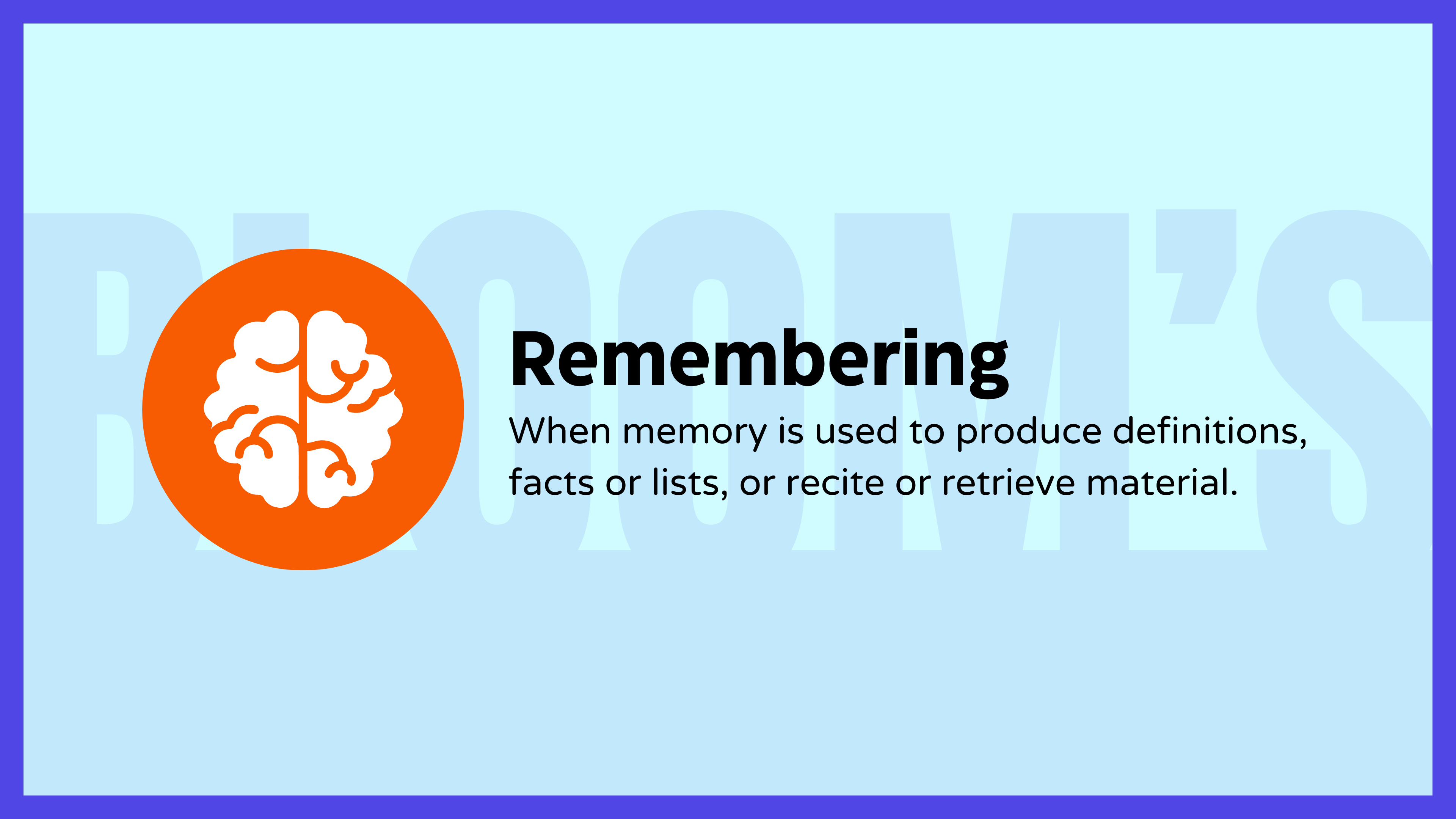
The goal of the “Remembering” level in Bloom’s Taxonomy is to assess students’ ability to recall facts, basic concepts, and information. At this foundational level, students are expected to retrieve knowledge from memory without necessarily understanding or analyzing it. This is crucial for building a solid base of knowledge upon which higher-order thinking skills can be developed.
- Question: “List the main components of a plant cell.”
(Suggested Answer: Cell wall, cell membrane, nucleus, chloroplasts, vacuole, cytoplasm.) - Question: “What is the capital of France?”
(Suggested Answer: Paris.) - Question: “Name the three states of matter.”
(Suggested Answer: Solid, liquid, gas.) - Question: “Who wrote ‘To Kill a Mockingbird’?”
(Suggested Answer: Harper Lee.) - Question: “What is the chemical symbol for water?”
(Suggested Answer: H₂O.) - Question: “Name the first president of the United States.”
(Suggested Answer: George Washington.) - Question: “What is the largest planet in our solar system?”
(Suggested Answer: Jupiter.) - Question: “Who painted the Mona Lisa?”
(Suggested Answer: Leonardo da Vinci.) - Question: “What year did the American Civil War begin?”
(Suggested Answer: 1861.) - Question: “What is the formula for calculating the area of a rectangle?”
(Suggested Answer: Length × Width.) - Question: “Name the three branches of the United States government.”
(Suggested Answer: Legislative, Executive, Judicial.) - Question: “What is the boiling point of water in degrees Celsius?”
(Suggested Answer: 100°C.) - Question: “Who is known as the Father of Computer Science?”
(Suggested Answer: Alan Turing.) - Question: “What is the main ingredient in traditional Japanese miso soup?”
(Suggested Answer: Miso paste.) - Question: “In what year did World War II end?”
(Suggested Answer: 1945.) - Question: “What is the capital of Japan?”
(Suggested Answer: Tokyo.) - Question: “Who discovered penicillin?”
(Suggested Answer: Alexander Fleming.) - Question: “What is the chemical symbol for gold?”
(Suggested Answer: Au.) - Question: “What is the largest mammal in the world?”
(Suggested Answer: Blue whale.) - Question: “Who wrote the play ‘Romeo and Juliet’?”
(Suggested Answer: William Shakespeare.)
Short Answer Questions for Bloom’s Taxonomy Level, Understanding
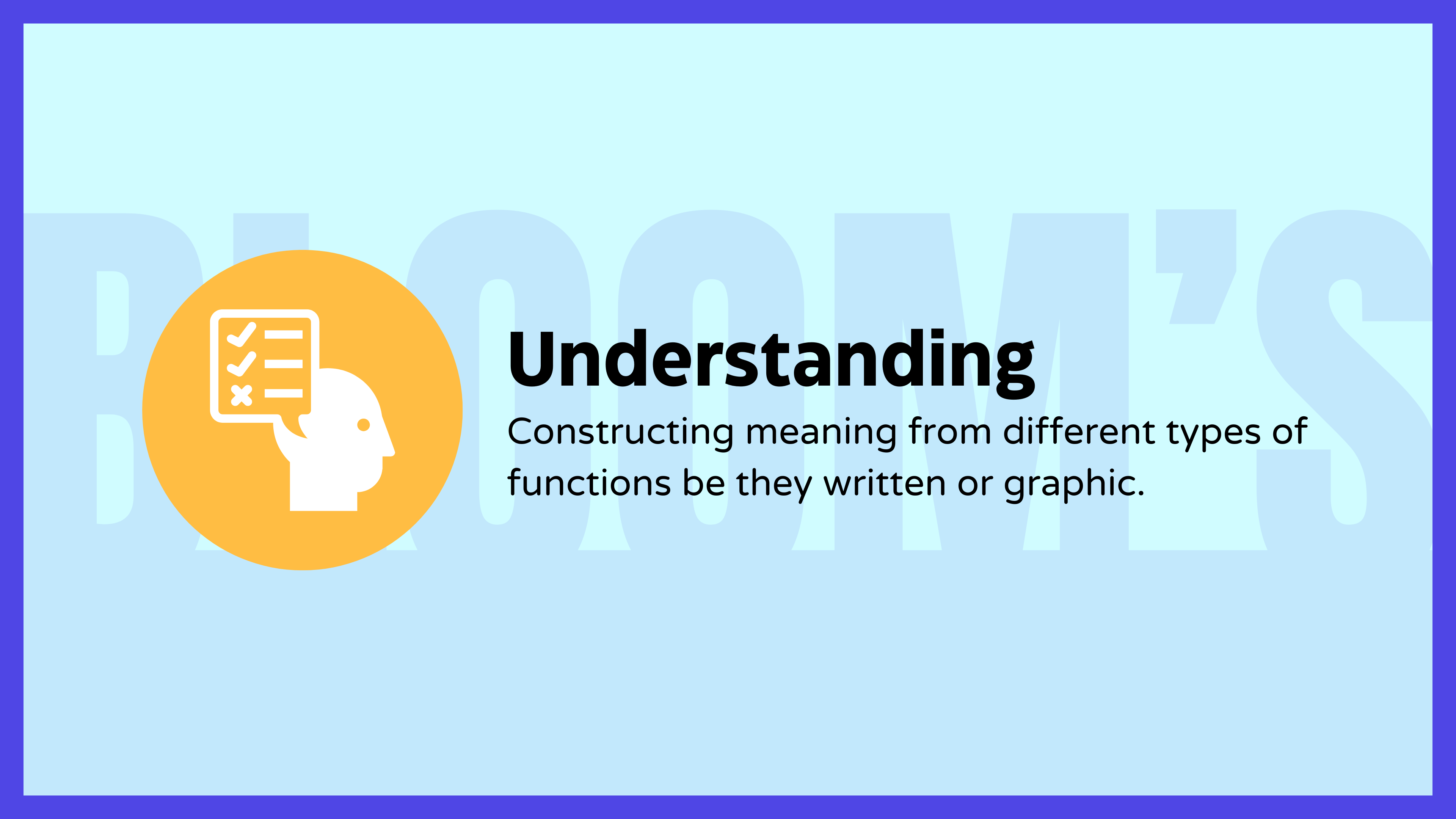
The goal of the “Understanding” level in Bloom’s Taxonomy is to assess students’ ability to comprehend information and explain concepts in their own words. At this level, students are expected to interpret, summarize, and infer meaning from the knowledge they have acquired. This foundational comprehension is crucial for applying knowledge to new situations and advancing to higher-order thinking.
- Question: “Explain the significance of the Berlin Wall in your own words.”
(Suggested Answer: The Berlin Wall separated East and West Berlin from 1961 to 1989, symbolizing the Cold War’s division between the communist East and the capitalist West.) - Question: “Describe the process of the water cycle in your own words.”
(Suggested Answer: The water cycle involves the evaporation of water, condensation to form clouds, and precipitation as rain or snow.) - Question: “Summarize the main beliefs of Buddhism.”
(Suggested Answer: Buddhism teaches the Four Noble Truths, the Eightfold Path, and the concepts of karma and reincarnation.) - Question: “What does the term ‘sustainable development’ mean?”
(Suggested Answer: Sustainable development refers to meeting the needs of the present without compromising the ability of future generations to meet their own needs.) - Question: “Explain the impact of globalization on local cultures.”
(Suggested Answer: Globalization can lead to the spread of international brands and cultural homogenization, but it can also encourage cultural exchange and diversity.) - Question: “Describe how photosynthesis works.”
(Suggested Answer: Photosynthesis is the process by which plants use sunlight to convert carbon dioxide and water into glucose and oxygen.) - Question: “What are the main causes of climate change?”
(Suggested Answer: Climate change is mainly caused by the burning of fossil fuels, deforestation, and industrial processes that increase greenhouse gases in the atmosphere.) - Question: “Explain the importance of the United Nations.”
(Suggested Answer: The United Nations promotes international cooperation, peace, and security, and works to address global issues like poverty and human rights.) - Question: “Describe the basic principles of democracy.”
(Suggested Answer: Democracy is based on principles of popular sovereignty, political equality, and the protection of human rights and freedoms.) - Question: “What is the function of the human respiratory system?”
(Suggested Answer: The respiratory system takes in oxygen and expels carbon dioxide, facilitating gas exchange in the lungs.) - Question: “Explain the concept of a free market economy.”
(Suggested Answer: A free market economy is an economic system where prices are determined by supply and demand with minimal government intervention.) - Question: “Describe the cultural significance of the Taj Mahal.”
(Suggested Answer: The Taj Mahal is a UNESCO World Heritage Site in India, symbolizing the rich history and architecture of the Mughal Empire and a monument to love.) - Question: “What are the main functions of the United Nations General Assembly?”
(Suggested Answer: The General Assembly discusses and makes recommendations on international issues, approves the UN budget, and elects non-permanent members of the Security Council.) - Question: “Explain the significance of Nelson Mandela’s leadership.”
(Suggested Answer: Nelson Mandela led the struggle against apartheid in South Africa, became the country’s first black president, and worked towards reconciliation and equality.) - Question: “Describe the process of mitosis.”
(Suggested Answer: Mitosis is the process of cell division where a single cell divides into two genetically identical daughter cells.) - Question: “What is the purpose of the Kyoto Protocol?”
(Suggested Answer: The Kyoto Protocol is an international treaty aimed at reducing greenhouse gas emissions to combat climate change.) - Question: “Explain the role of the International Monetary Fund (IMF).”
(Suggested Answer: The IMF provides financial support and advice to countries facing economic instability, promoting global monetary cooperation and financial stability.) - Question: “Describe the significance of the Rosetta Stone.”
(Suggested Answer: The Rosetta Stone was key to deciphering Egyptian hieroglyphs, allowing scholars to understand ancient Egyptian language and culture.) - Question: “What are the basic principles of Hinduism?”
(Suggested Answer: Hinduism is based on principles like dharma (duty/ethics), karma (action/consequence), and moksha (liberation from the cycle of rebirth).) - Question: “Explain the importance of the Amazon rainforest.”
(Suggested Answer: The Amazon rainforest is crucial for biodiversity, climate regulation, and indigenous cultures; it acts as a major carbon sink and produces oxygen.)
Short Answer Questions for Bloom’s Taxonomy Level, Applying
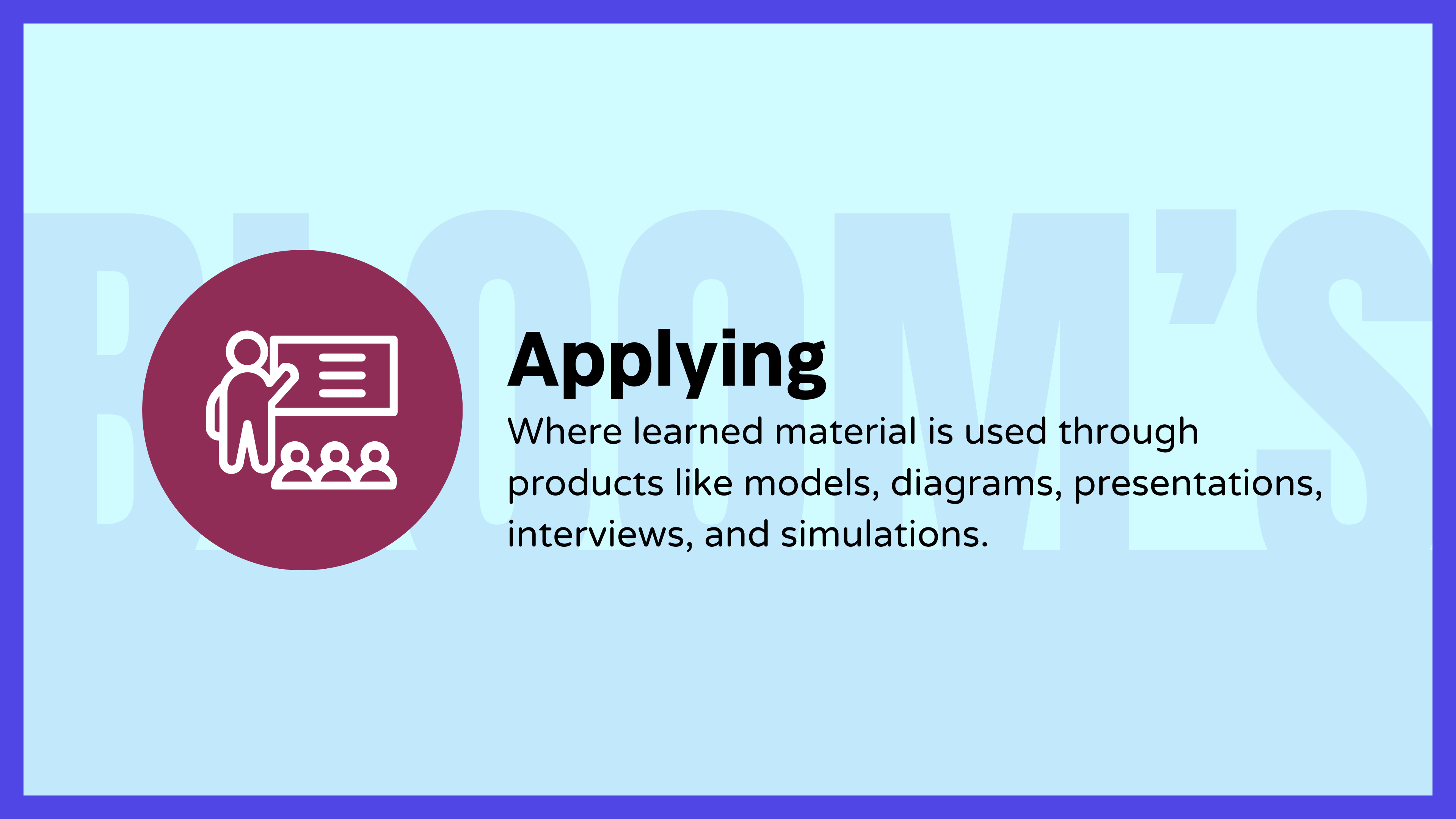
The goal of the “Applying” level in Bloom’s Taxonomy is to assess students’ ability to use information in new situations. At this level, students are expected to apply their knowledge and skills to solve problems, demonstrate procedures, and implement concepts in practical contexts. This is crucial for bridging the gap between theoretical understanding and real-world application.
- Question: “Apply the concept of gravity to explain why objects fall to the ground.”
(Suggested Answer: Gravity is the force that pulls objects towards the center of the Earth, causing them to fall when dropped.) - Question: “How would you use the Pythagorean theorem to find the length of the hypotenuse in a right triangle with legs of 3 cm and 4 cm?”
(Suggested Answer: Using the Pythagorean theorem, a2+b2=c2a2+b2=c2, the hypotenuse is 5 cm.) - Question: “Describe how you would conduct an experiment to test the effects of sunlight on plant growth.”
(Suggested Answer: Plant seeds in identical conditions, expose them to different amounts of sunlight, and measure their growth over time.) - Question: “How can you apply the principles of healthy eating to plan a balanced diet?”
(Suggested Answer: Include a variety of fruits, vegetables, whole grains, proteins, and dairy, and limit processed foods and sugars.) - Question: “Use the concept of supply and demand to explain why the price of a popular toy might increase before the holidays.”
(Suggested Answer: Increased demand for the toy before the holidays can lead to higher prices as supply becomes limited.) - Question: “How would you implement the steps of the scientific method to investigate a question about the effects of caffeine on concentration?”
(Suggested Answer: Form a hypothesis, design an experiment, collect data, analyze the results, and draw conclusions.) - Question: “Apply the principles of democracy to describe how a citizen can participate in their government.”
(Suggested Answer: Citizens can vote in elections, attend town meetings, join political parties, or contact their representatives.) - Question: “How can you use basic first aid principles to treat a minor cut?”
(Suggested Answer: Clean the wound, apply an antiseptic, and cover it with a sterile bandage.) - Question: “Describe how you would use a map and compass to navigate a hiking trail.”
(Suggested Answer: Use the compass to find your direction, follow the map’s trail markers, and adjust your route as needed.) - Question: “Apply the concept of renewable energy to propose a solution for reducing fossil fuel usage in your community.”
(Suggested Answer: Implement solar panels on public buildings, encourage the use of electric vehicles, and promote energy-efficient practices.) - Question: “How can you use the water cycle to explain the importance of conserving water?”
(Suggested Answer: Conserving water helps maintain the balance of the water cycle and ensures a sustainable supply for all uses.) - Question: “Use the principles of effective communication to resolve a conflict between classmates.”
(Suggested Answer: Listen actively, acknowledge each other’s viewpoints, and find a compromise that satisfies both parties.) - Question: “Apply the concept of ecosystem balance to explain the impact of removing a predator from an environment.”
(Suggested Answer: Removing a predator can lead to overpopulation of prey species, which can disrupt the balance of the ecosystem.) - Question: “How would you use budgeting principles to manage your monthly allowance?”
(Suggested Answer: Track income and expenses, set savings goals, and allocate funds for necessities and discretionary spending.) - Question: “Describe how you can apply time management strategies to improve your study habits.”
(Suggested Answer: Create a study schedule, prioritize tasks, and set specific goals for each study session.) - Question: “How can you use the concept of empathy to improve your interactions with others?”
(Suggested Answer: Understand and share the feelings of others, listen without judgment, and respond with compassion.) - Question: “Apply the principles of environmental conservation to suggest ways to reduce plastic waste.”
(Suggested Answer: Use reusable bags and containers, recycle plastics, and avoid single-use plastic products.) - Question: “How would you use critical thinking skills to evaluate the credibility of a news source?”
(Suggested Answer: Check the source’s reputation, verify facts with other sources, and look for potential biases.) - Question: “Apply the concept of cultural awareness to explain how you would interact with someone from a different background.”
(Suggested Answer: Show respect for their customs and traditions, ask questions to learn more, and be open-minded and inclusive.) - Question: “Describe how you can use the principles of teamwork to complete a group project successfully.”
(Suggested Answer: Assign roles based on strengths, communicate effectively, set clear goals, and collaborate to solve problems.)
Short Answer Questions for Bloom’s Taxonomy Level, Analyzing
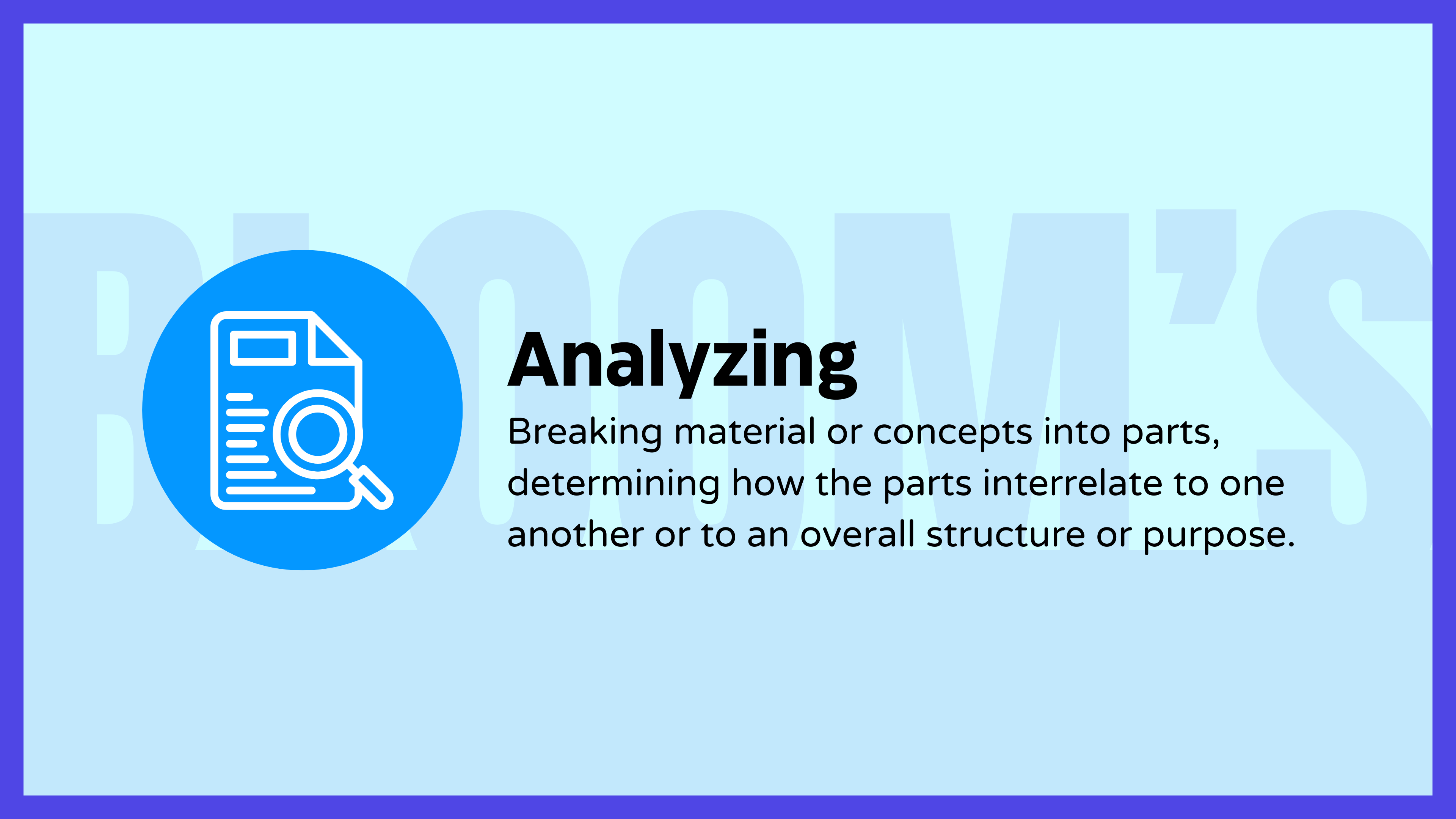
The goal of the “Analyzing” level in Bloom’s Taxonomy is to assess students’ ability to break down information into its components, understand relationships between parts, and recognize patterns. At this level, students are expected to compare, contrast, categorize, and identify causes and effects. This is crucial for developing critical thinking skills and deeper comprehension.
- Question: “Analyze the differences between renewable and nonrenewable energy sources.”
(Suggested Answer: Renewable energy sources, such as solar and wind, can be replenished naturally and are sustainable, whereas nonrenewable sources, like coal and oil, are finite and contribute to environmental pollution.) - Question: “Compare and contrast the leadership styles of Mahatma Gandhi and Martin Luther King Jr.”
(Suggested Answer: Both leaders advocated for nonviolent resistance, but Gandhi focused on India’s independence from British rule, while King aimed to achieve civil rights for African Americans in the United States.) - Question: “Identify the causes and effects of deforestation.”
(Suggested Answer: Causes include logging, agriculture, and urbanization. Effects include loss of biodiversity, climate change, and disruption of water cycles.) - Question: “Analyze the impact of social media on modern communication.”
(Suggested Answer: Social media has increased connectivity and information sharing but also led to issues like misinformation, reduced privacy, and superficial relationships.) - Question: “Compare the economic systems of capitalism and socialism.”
(Suggested Answer: Capitalism is based on private ownership and free markets, while socialism advocates for public ownership and equal distribution of resources.) - Question: “Identify the key components of a persuasive argument.”
(Suggested Answer: A persuasive argument includes a clear thesis, supporting evidence, counterarguments, and a conclusion.) - Question: “Analyze the effects of colonialism on indigenous populations.”
(Suggested Answer: Colonialism often led to the exploitation and displacement of indigenous peoples, loss of cultural heritage, and economic dependence.) - Question: “Compare the themes of love and revenge in Shakespeare’s ‘Hamlet’.”
(Suggested Answer: Love is portrayed through Hamlet’s relationships, while revenge drives the plot, leading to tragic consequences.) - Question: “Identify the factors that contributed to the fall of the Roman Empire.”
(Suggested Answer: Factors include political instability, economic decline, military defeats, and invasions by barbarian tribes.) - Question: “Analyze the relationship between diet and health.”
(Suggested Answer: A balanced diet provides essential nutrients, supports overall health, and prevents chronic diseases, while poor dietary habits can lead to obesity, heart disease, and other health issues.) - Question: “Compare the impacts of the Industrial Revolution in Europe and Asia.”
(Suggested Answer: In Europe, the Industrial Revolution led to urbanization and economic growth, while in Asia, it often resulted in colonization and exploitation by European powers.) - Question: “Identify the main arguments for and against globalization.”
(Suggested Answer: Arguments for include economic growth, cultural exchange, and technological advancement. Arguments against include loss of local cultures, economic inequality, and environmental degradation.) - Question: “Analyze the role of women in World War II.”
(Suggested Answer: Women took on roles in the workforce, military, and resistance movements, significantly contributing to the war effort and changing societal perceptions of gender roles.) - Question: “Compare the political ideologies of liberalism and conservatism.”
(Suggested Answer: Liberalism emphasizes individual freedoms, social equality, and government intervention for social justice, while conservatism values tradition, limited government, and free-market principles.) - Question: “Identify the causes and effects of urbanization.”
(Suggested Answer: Causes include industrialization and economic opportunities. Effects include population growth in cities, infrastructure development, and social challenges like housing shortages and pollution.) - Question: “Analyze the significance of the scientific method in research.”
(Suggested Answer: The scientific method provides a systematic approach to investigation, ensuring objectivity, reproducibility, and validity in research findings.) - Question: “Compare the health benefits of aerobic and anaerobic exercise.”
(Suggested Answer: Aerobic exercise improves cardiovascular health and endurance, while anaerobic exercise enhances muscle strength and power.) - Question: “Identify the main characteristics of a dystopian society in literature.”
(Suggested Answer: Common characteristics include oppressive governments, lack of freedoms, widespread surveillance, and a bleak or controlled environment.) - Question: “Analyze the impact of technological advancements on employment.”
(Suggested Answer: Technological advancements can lead to job creation in new industries but also result in job displacement due to automation and changes in required skill sets.) - Question: “Compare the cultural significance of the Olympic Games in ancient Greece and modern times.”
(Suggested Answer: In ancient Greece, the Olympics were a religious and athletic festival honoring Zeus, promoting unity among city-states. In modern times, they represent global unity, athletic excellence, and international cooperation.)
Short Answer Questions for Bloom’s Taxonomy Level, Evaluating
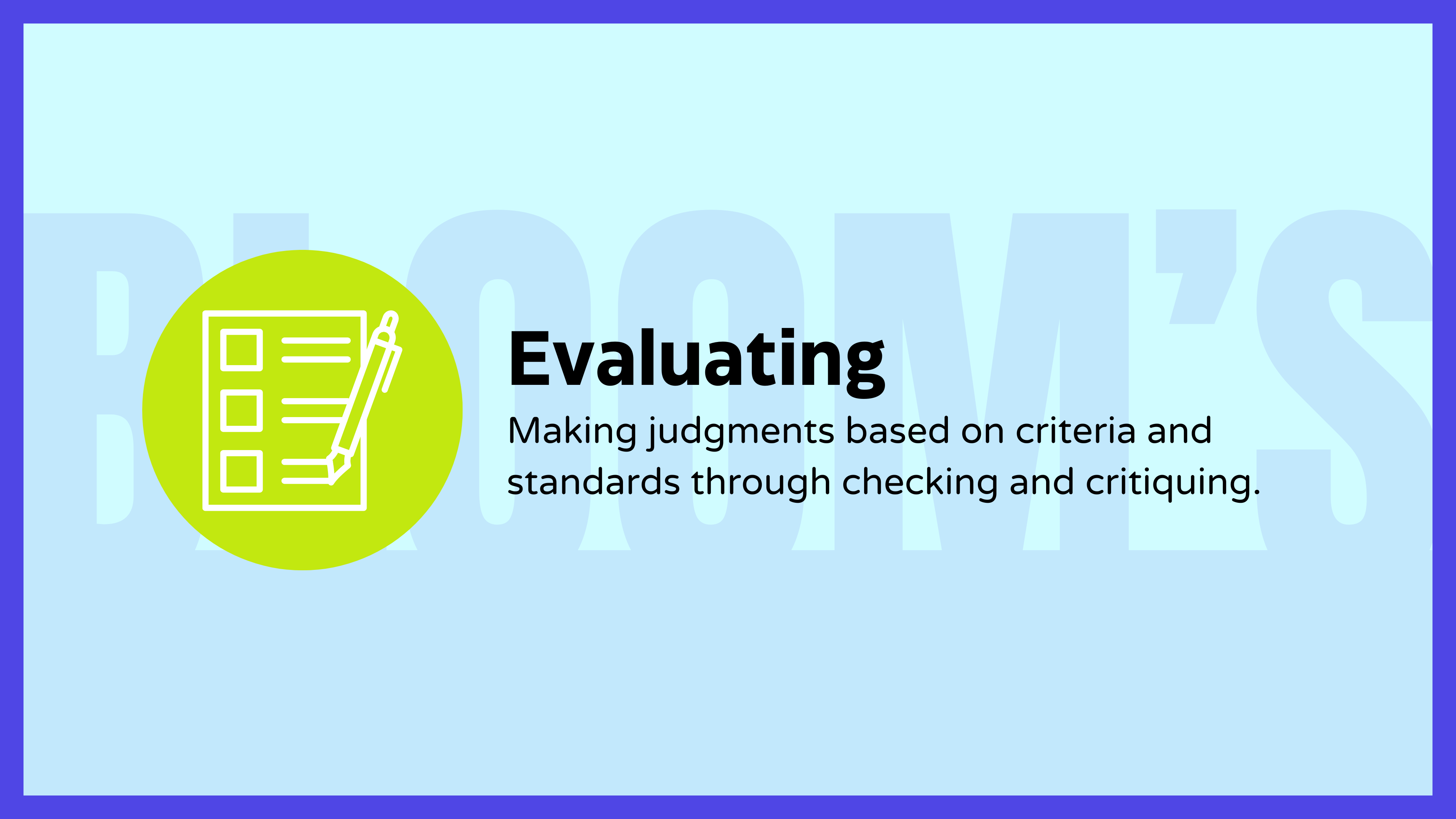
The goal of the “Evaluating” level in Bloom’s Taxonomy is to assess students’ ability to make judgments based on criteria and standards. At this level, students are expected to critique, justify, and support their opinions or decisions. This is crucial for developing critical thinking and decision-making skills.
- Question: “Evaluate the effectiveness of the United Nations in maintaining global peace.”
(Suggested Answer: The UN has been effective in preventing large-scale conflicts and providing humanitarian aid, but it faces challenges like political bias and lack of enforcement power.) - Question: “Justify the importance of renewable energy sources over fossil fuels.”
(Suggested Answer: Renewable energy sources are sustainable, reduce greenhouse gas emissions, and decrease dependence on finite resources, making them crucial for environmental conservation.) - Question: “Critique the impact of social media on interpersonal relationships.”
(Suggested Answer: Social media enhances connectivity and communication but can also lead to superficial interactions, cyberbullying, and decreased face-to-face communication skills.) - Question: “Evaluate the arguments for and against the use of genetically modified organisms (GMOs) in agriculture.”
(Suggested Answer: Proponents argue GMOs increase crop yields and resistance to pests, while opponents raise concerns about environmental impact and food safety.) - Question: “Justify the need for stricter environmental regulations.”
(Suggested Answer: Stricter regulations are necessary to combat climate change, protect ecosystems, and ensure public health by reducing pollution and conserving natural resources.) - Question: “Critique the effectiveness of standardized testing in measuring student performance.”
(Suggested Answer: Standardized tests provide a uniform assessment method but may not accurately reflect a student’s abilities and can lead to teaching to the test.) - Question: “Evaluate the benefits and drawbacks of remote work.”
(Suggested Answer: Benefits include flexibility and reduced commuting, while drawbacks can be isolation, difficulty in collaboration, and maintaining work-life balance.) - Question: “Justify the inclusion of arts education in the school curriculum.”
(Suggested Answer: Arts education fosters creativity, critical thinking, and cultural awareness, contributing to well-rounded development and academic success.) - Question: “Critique the role of multinational corporations in developing countries.”
(Suggested Answer: Multinational corporations can boost economic growth and create jobs, but they may also exploit labor, harm the environment, and undermine local businesses.) - Question: “Evaluate the impact of global tourism on local cultures.”
(Suggested Answer: Tourism can promote cultural exchange and economic development but may also lead to cultural commodification and environmental degradation.) - Question: “Justify the need for public healthcare systems.”
(Suggested Answer: Public healthcare systems ensure equitable access to medical services, improve public health outcomes, and reduce overall healthcare costs.) - Question: “Critique the effectiveness of international trade agreements.”
(Suggested Answer: Trade agreements can enhance economic cooperation and growth but may also result in job losses in certain sectors and increased economic inequality.) - Question: “Evaluate the role of technology in education.”
(Suggested Answer: Technology enhances learning through interactive tools and access to information but can also lead to distractions and a digital divide among students.) - Question: “Justify the importance of preserving endangered species.”
(Suggested Answer: Preserving endangered species maintains biodiversity, ensures ecosystem balance, and supports the health of the planet.) - Question: “Critique the impact of fast fashion on the environment.”
(Suggested Answer: Fast fashion contributes to environmental pollution, waste, and the depletion of resources, highlighting the need for sustainable practices.) - Question: “Evaluate the success of the Paris Agreement in addressing climate change.”
(Suggested Answer: The Paris Agreement has increased global commitment to reducing emissions, but its success is limited by insufficient enforcement and varying national efforts.) - Question: “Justify the need for financial literacy education in schools.”
(Suggested Answer: Financial literacy education equips students with essential skills to manage money, make informed financial decisions, and achieve economic stability.) - Question: “Critique the role of the media in shaping public opinion.”
(Suggested Answer: The media can inform and educate the public but may also perpetuate biases, misinformation, and sensationalism.) - Question: “Evaluate the ethical considerations of artificial intelligence.”
(Suggested Answer: AI offers significant benefits but raises ethical issues such as privacy, job displacement, and decision-making transparency.) - Question: “Justify the implementation of universal basic income.”
(Suggested Answer: Universal basic income can reduce poverty, provide financial security, and stimulate economic growth, but it requires careful consideration of funding and potential disincentives to work.)
Short Answer Questions for Bloom’s Taxonomy Level, Creating
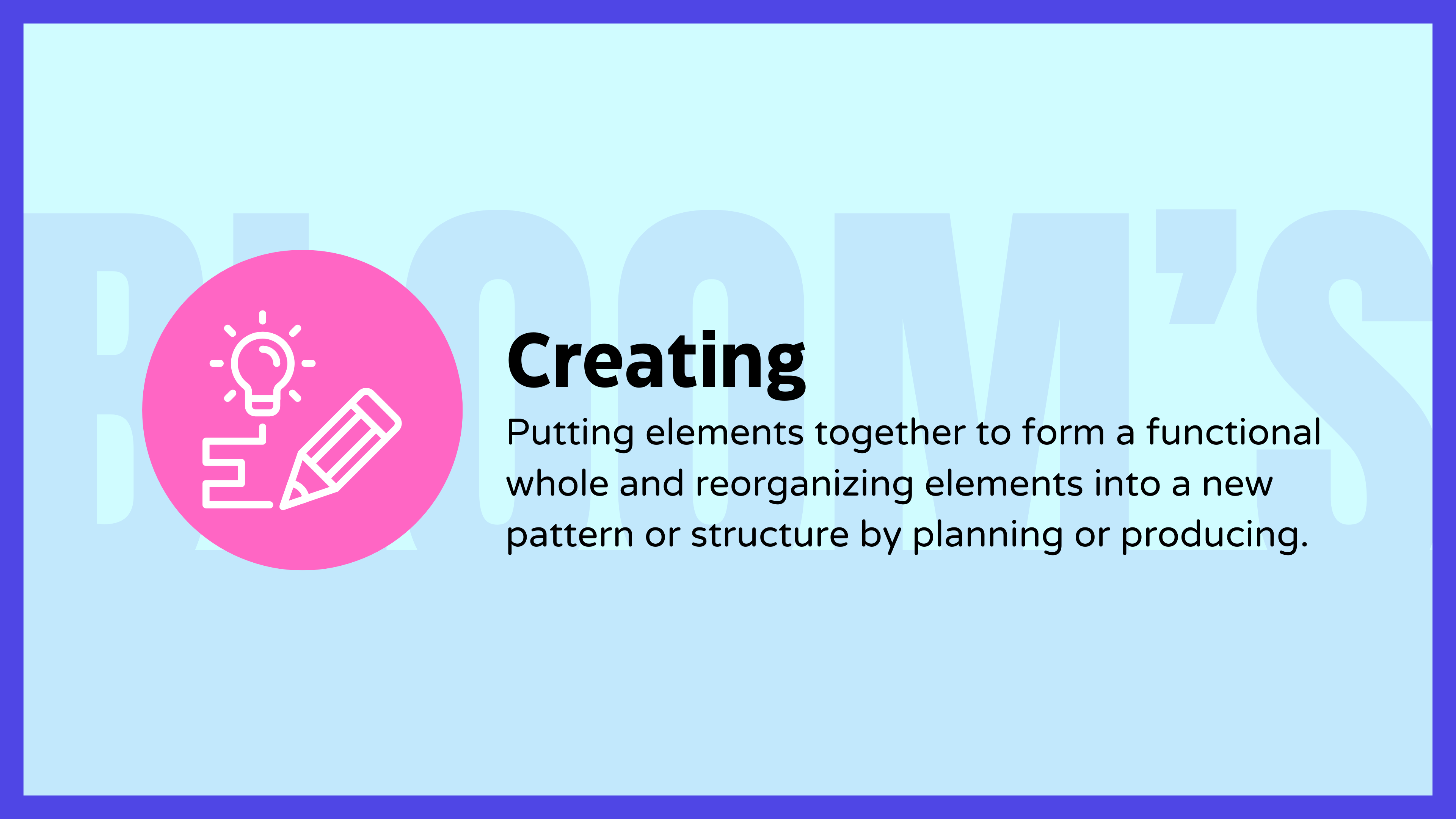
The goal of the “Creating” level in Bloom’s Taxonomy is to assess students’ ability to generate new ideas, products, or ways of understanding. At this level, students are expected to synthesize information, design solutions, and invent new approaches. This is crucial for fostering creativity, innovation, and advanced problem-solving skills.
- Question: “Design a marketing campaign to promote recycling in your community.”
(Suggested Answer: Create posters and social media content highlighting the benefits of recycling, organize community events, and partner with local businesses for incentives.) - Question: “Invent a new device that could help reduce plastic waste.”
(Suggested Answer: Design a portable plastic compactor that can be used in homes to compress plastic waste for easier recycling.) - Question: “Compose a poem about the importance of biodiversity.”
(Suggested Answer: Write a poem that emphasizes the beauty of diverse ecosystems and the role of every species in maintaining environmental balance.) - Question: “Develop a plan for a school garden that includes both vegetables and flowers.”
(Suggested Answer: Outline the layout, list the types of plants, assign responsibilities for maintenance, and plan activities for students to learn about gardening.) - Question: “Create a short story based on the theme of overcoming adversity.”
(Suggested Answer: Write a story about a character facing significant challenges who ultimately triumphs through determination and support from others.) - Question: “Design an app that helps students organize their homework and study schedules.”
(Suggested Answer: Include features like a calendar, reminders, subject-specific notes, and progress tracking to help students stay organized and manage their time effectively.) - Question: “Invent a sustainable energy solution for a small village without access to electricity.”
(Suggested Answer: Propose a solar panel system with battery storage to provide reliable and renewable energy to the village.) - Question: “Compose a song that teaches children about the water cycle.”
(Suggested Answer: Write catchy lyrics and a melody that explain evaporation, condensation, and precipitation in an engaging way for young learners.) - Question: “Develop a strategy for reducing food waste in your home.”
(Suggested Answer: Plan meals carefully, store food properly, use leftovers creatively, and compost organic waste.) - Question: “Create a board game that teaches players about world geography.”
(Suggested Answer: Design a game with maps, trivia questions, and challenges that help players learn about different countries, capitals, and landmarks.) - Question: “Design a public awareness campaign to combat cyberbullying.”
(Suggested Answer: Develop educational materials, social media content, and workshops to raise awareness about the effects of cyberbullying and how to prevent it.) - Question: “Invent a new type of packaging that is environmentally friendly.”
(Suggested Answer: Create packaging made from biodegradable materials that can be easily recycled or composted after use.) - Question: “Compose a letter to a local government official advocating for improved public transportation.”
(Suggested Answer: Write a persuasive letter highlighting the benefits of better public transportation for reducing traffic, pollution, and improving community access.) - Question: “Develop a curriculum for an after-school program focused on coding and robotics.”
(Suggested Answer: Plan lessons that teach basic coding skills, build simple robots, and incorporate fun projects to engage students.) - Question: “Create a vision board for your career goals and aspirations.”
(Suggested Answer: Gather images, quotes, and items that represent your career aspirations and arrange them on a board to visualize your future path.) - Question: “Design a new toy that encourages physical activity in children.”
(Suggested Answer: Invent a toy that combines fun with exercise, like a dance mat with interactive games or a jump rope with a digital counter.) - Question: “Compose a speech on the importance of mental health awareness.”
(Suggested Answer: Write a speech that discusses the significance of mental health, common challenges, and ways to support mental well-being.) - Question: “Develop a project plan for building a community library.”
(Suggested Answer: Outline the steps for securing funding, selecting a location, gathering books and resources, and organizing volunteers.) - Question: “Invent a new sport that can be played indoors during winter.”
(Suggested Answer: Create a sport that combines elements of existing indoor activities, like indoor hockey with soft pucks and safe equipment.) - Question: “Design a website that educates people about climate change and sustainability.”
(Suggested Answer: Include sections on the science of climate change, practical tips for reducing carbon footprints, and ways to get involved in sustainability efforts.)
Here is a list of comprehensive Bloom's Taxonomy verbs to upgrade your teaching by speaking to your students in strategic language.
Creating Interactive Short Answers Quiz Questions in PowerPoint
Short answer questions can be a powerful tool for assessing student understanding, but they become even more engaging and effective when made interactive. With ClassPoint, you can easily transform your traditional short answer questions into dynamic, interactive experiences that keep students engaged and provide real-time feedback. Here’s a brief guide on how to do it:

- Prepare your slides
- Open your PowerPoint presentation and create a question slide using the available question examples in this blog. Ensure that you’re having only one question per slide, as you are only allowed to have one interactive quiz question button in a single slide.
- Sign up and install ClassPoint
- Visit the ClassPoint website to download and install the add-in for free. ClassPoint integrates seamlessly with PowerPoint, so you don’t have to download additional tools for support.
- Set up your interactive Short Answer
- Once you have your question slide set up, navigate to the ClassPoint tab in your PowerPoint ribbon and choose the “Short Answer” quiz type from the quiz features. Once inserted, you’d have play options available so you can setup question settings depending on your assessment needs.
- Launch your Short Answer quiz in slide show
- In slide show, invite your students to join your class by giving them the unique code displayed at the top-right corner of your slide. Have them input this code at classpoint.app using any browser of any device. Then, start the quiz by clicking the embedded Short Answer button on your slide.
- Receive student responses real-time
- As students submit their answers, you’d be able to see their responses coming in live via the active quiz window right on your screen. ClassPoint also has a real-time monitoring feature so you can see who has already submitted and who has yet to do so. This way, you can decide accordingly whether to close the submissions already or extend it.
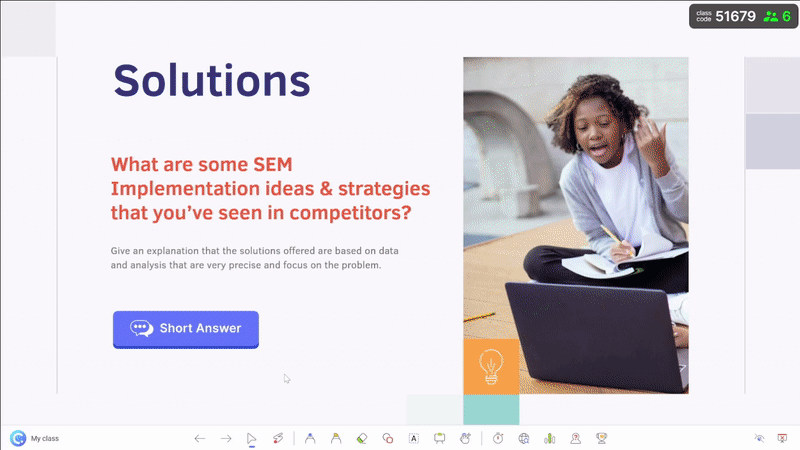
- Display Leaderboard Updates
- Keep the excitement high by showing a visual scoreboard after each question to give everyone updates on their current quiz performance. This visual representation of scores fosters a competitive and engaging environment.
- Conclude with Recognition
- End your quiz by revealing the final leaderboard and recognizing the top performers. Top 3 will be showcased via a virtual podium with all others listed accordingly. This helps celebrate students’ achievements and encourages continued participation in future interactive quizzes.
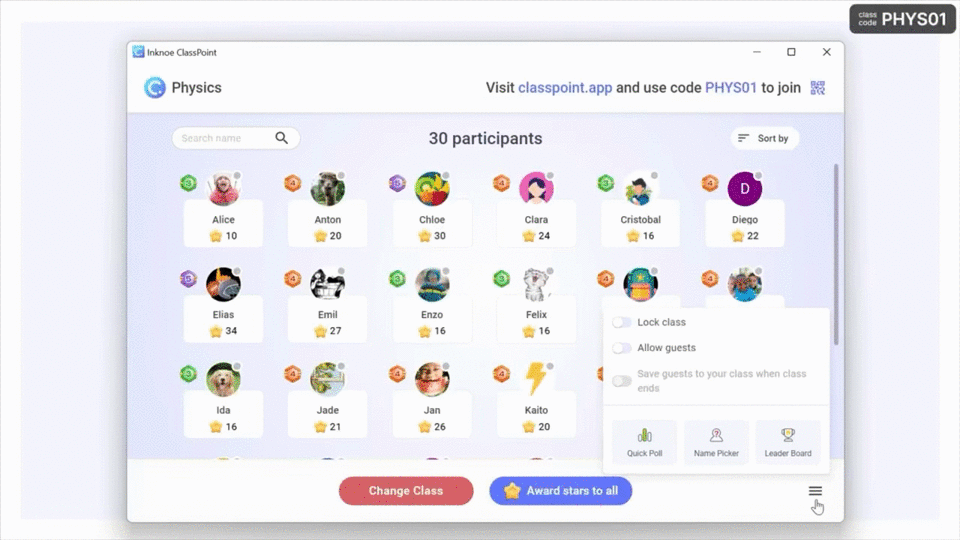
For a full tutorial on how you can create Short Answer quizzes in PowerPoint, watch this video 👇
Bonus Tips: Use AI to generate short answer quizzes
Tired of brainstorming Short Answer quiz questions from the scratch? With an AI quiz generator, you can create short answer questions with suggested answers in just a matter of a few clicks. The AI will read your PowerPoint slide content and generate relevant questions according to your teaching material. How cool is it?
Learn how to create Short Answer quizzes instantly with AI quiz generator.
Food for Thought
Incorporating short answer questions across Bloom’s Taxonomy levels offers a structured approach to fostering various cognitive skills in students, from basic recall to creative thinking. These questions not only provide a clear measure of student understanding but also encourage deeper engagement with the material. By carefully designing and implementing these questions, educators can support holistic learning experiences that cater to diverse learning needs.
With tools like ClassPoint, making short answer questions interactive has never been easier. This integration brings a new dimension to traditional assessments, transforming them into engaging, real-time activities that captivate students’ attention and enhance their learning outcomes. By leveraging the power of interactive technology, teachers can create a dynamic classroom environment that motivates students and fosters a love for learning.
Comments
Post a Comment